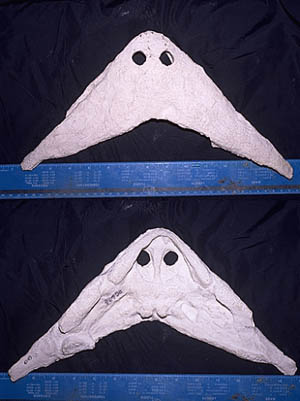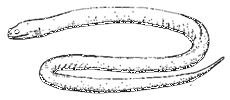 Microsauria:
Microsauria:| Lepospondyli | ||
| The Vertebrates | Lepospondyli |
| Vertebrates Home | Vertebrate | Vertebrate |
|
Abbreviated Dendrogram
Reptiliomorpha
│
└─Lepospondyli
├─Microsauria
└─┬─Lysorophia
└─┬─Adelogyrinidae
└─┬─Nectridia
└─Aïstopoda
|
Contents
|
from the Early Carboniferous.
Batrachosauria: Seymouriamorpha + * : Microsauria + (Lysorophia + Adelogyrinidae + (Nectridia + Aïstopoda)))
Possibly paraphyletic group united mostly by relatively small size and lack of labyrinthodont dentition. Single, spool-shaped vertebral centrum. May be stem group for Lissamphibia, rather than temnospondyls. Others eliminate this taxon altogether.
Links: Amphibia [Lepospondyli after Laurin & Reisz, 1997]; Amphibians. ATW030204
C–P of NAm. and Eur.
Lepospondyli : (Lysorophia + (Adelogyrinidae + (Nectridia + Aïstopoda))) + *.
Introduction: The microsaurs ("small lizards") are a diverse group of small prehistorical amphibians of the Carboniferous and Permian periods. Some were terrestrial and lizard-like, others aquatic and newt-like. There were even specialised burrowing forms. Included as part of the "lepospondyl" group, they may be more closely related to temnospondyls. (MAK 931010)
Single bone in temporal series (tabular). All have limbs, usu. small. Many terrestrial and lizard-like with deep skulls, elongate.
Lysorophia: Lysorophus, Cocytinus.
Pennsylvanian to Cisuralian of North America (Eastern U.S.)
Lepospondyli :: (Adelogyrinidae + (Nectridia + Aïstopoda)) + *.
fenestrate skulls, parietal foramen absent [2]; postfrontal, postorbital, supratemporal, jugal, quadratojugal, ectopterygoid, coronoids, and postsplenial absent [2]; anteriorly sloping suspensoria; parasphenoid broad, with poorly differentiated cultriform process [2]; short mandibles (each bearing a lateral mandibular fenestra); dentition not labyrinthodont[2]; denticles and fangs on the vomer and palatine absent [2], parasymphysial fangs absent [2]; extensive, well-ossified hyobranchial skeletons; elongate bodies, vertebral centra composed of a single, cylindrical ossification [2]; neural arch halves sutured at midlines and to centra; anterior surface of atlantal centrum broader than its posterior surface [2]; distinct atlantal odontoid process present [2]; greatly reduced limbs; dermal sculpture absent [2],
Notes: [1] Highly derived relative to other Paleozoic amphibians. Most closely related to Microsauria, based on morphology of the craniovertebral articulation. [2] synapomorphies shared with Lissamphibia
Links: link; Phylogeny of Stegocephalians; ATW040114.
Adelogyrinidae: Adelogyrinus, Adelospondylus, Dolichopareias, Palaeomolgophis.
Early Carboniferous (Visean to Serpukhovian) of Europe.
Phylogeny: Lepospondyli ::: (Nectridia + Aïstopoda) + *.
Long trunk, but with limb girdles; orbits very far forward; solid skull roof. (Crassigyrinus originally thought to be in this group).
Links: link. ATW021021.
 Nectridia: Ctenerpeton, Diplocaulus, Keraterpeton, Sauropleura, Scincosaurus.
Nectridia: Ctenerpeton, Diplocaulus, Keraterpeton, Sauropleura, Scincosaurus.
lwC–upP (lwP?) of Eur., NAm, and NAfr.
Lepospondyli :::: Aïstopoda + *.
Introduction: The Nectridia were a group of small to medium-sized paleozoic amphibians, mostly aquatic, usually included within the lepospondyl group. Most forms resemble modern newts, with elongate flatened tails. A few late specialised forms however developed strange boomerang-shape heads. These remarkable heads probably served as hydrofoils to provide lift in slow-moving streams. The Nectridia were a surprisingly succesful group during the Early Permian, but may have been unable to cope with the increasingly arid conditions at the end of the Permian, and died out without leaving any descendants.
The nectridians are best known from Diplocaulus and similar small to medium sized (length to 50 or 100 cm) members of the Keraterpontidae, the most extreme members of the Nectridean group, characterised by skulls possessing large backward or sideways directed "horns" or perhaps more accurately, hydroplanes. Keraterpontidae would have fed on small fish and aquatic invertebrates, and were themselves preyed upon by larger amphibians and freshwater sharks. (MAK 981010)
Primitively, skull table narrow and moveable on jugal; tabular horns in some forms (Keraterpetontidae); primitively, skull table narrow and moveable on jugal; some skull kinesis (Diplocaulids lose kinesis – very large tabular horns); body laterally compressed, fan-shaped, symmetrical neural and hemal arches; little flexibility in trunk; elongate in tail (not trunk); trunk limbs interdigitate through neural spines; limbs small; secondarily aquatic.
Diplocaulus - Paleontology and Geology Glossary; lect11.html; TMMSH - Exhibits - Scratching the Surface - Diplocaulus; Diplocaulus ????????; Chamworks Dinosaurs & Such: Diplocaulus sp.; DIPLOCAULUS; Timelines | American Museum of Natural History.
 Aïstopoda: Ophiderpeton see image)
Aïstopoda: Ophiderpeton see image)
Range: Early Carboniferous to Early Permian of North America & Europe.
Phylogeny: Lepospondyli :::: Nectridia + *.
 Introduction: The aïstopods were a small group of specialised limbless amphibians. In appearance and quite probably in movement too, they resembled snakes. Their bodies were extremely elongated, the torso containing up to 200 vertebrae, or even more, while the tail was short and primitive. The skull was very specialised, with fusion and loss of bones in the snout, cheek, and top of the head. In advanced forms the skull became a series of struts that supported the braincase against the lower jaw, just as in snakes. The evolutionary relationships to other groups are not known with confidence, but it seems that they diverged quiet early from other lineages. Aïstopod vertebrae are very similiar in structure to nectridan vertebrae, and the two groups are usually connected within the lepospondyls.
Introduction: The aïstopods were a small group of specialised limbless amphibians. In appearance and quite probably in movement too, they resembled snakes. Their bodies were extremely elongated, the torso containing up to 200 vertebrae, or even more, while the tail was short and primitive. The skull was very specialised, with fusion and loss of bones in the snout, cheek, and top of the head. In advanced forms the skull became a series of struts that supported the braincase against the lower jaw, just as in snakes. The evolutionary relationships to other groups are not known with confidence, but it seems that they diverged quiet early from other lineages. Aïstopod vertebrae are very similiar in structure to nectridan vertebrae, and the two groups are usually connected within the lepospondyls.
Characters: 5-100 cm; very elongate; some with snake-like kinetic, fenestrated crania; orbits large and located far anteriorly; jaws with wide gape; no limbs or limb girdles; up to 230 vertebrae; vertebrae holospondylous and deeply amphicoelous; only 1 vertebral ossification per segment; rib heads K-shaped; vertebral column with well-defined cervical, thoeacic and caudal regions; tail not flattened (as in aquatic forms).
Links: link, image; NRC Research Press: Canadian Journal of Earth Sciences abstract); OBERSEMINAR – VORTRAG. German: good short discussion, but the comments on lifestyle are very speculative); Aistopoda Mikko's Phylogeny); Dino Land Travels Database Redpath Museum- Aïstopods; Nathis Fauna Amphibiën - Primitieve Terapoden Dutch). ATW040705.
checked ATW060209